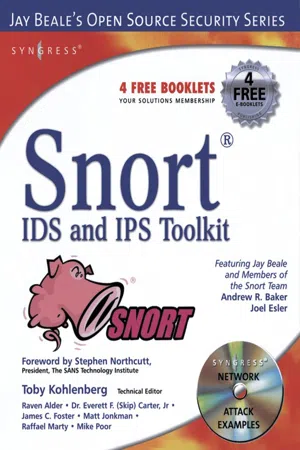
- 768 pages
- English
- ePUB (mobile friendly)
- Available on iOS & Android
Snort Intrusion Detection and Prevention Toolkit
About This Book
This all new book covering the brand new Snort version 2.6 from members of the Snort developers team.This fully integrated book and Web toolkit covers everything from packet inspection to optimizing Snort for speed to using the most advanced features of Snort to defend even the largest and most congested enterprise networks. Leading Snort experts Brian Caswell, Andrew Baker, and Jay Beale analyze traffic from real attacks to demonstrate the best practices for implementing the most powerful Snort features. The book will begin with a discussion of packet inspection and the progression from intrusion detection to intrusion prevention. The authors provide examples of packet inspection methods including: protocol standards compliance, protocol anomaly detection, application control, and signature matching. In addition, application-level vulnerabilities including Binary Code in HTTP headers, HTTP/HTTPS Tunneling, URL Directory Traversal, Cross-Site Scripting, and SQL Injection will also be analyzed. Next, a brief chapter on installing and configuring Snort will highlight various methods for fine tuning your installation to optimize Snort performance including hardware/OS selection, finding and eliminating bottlenecks, and benchmarking and testing your deployment. A special chapter also details how to use Barnyard to improve the overall performance of Snort. Next, best practices will be presented allowing readers to enhance the performance of Snort for even the largest and most complex networks. The next chapter reveals the inner workings of Snort by analyzing the source code. The next several chapters will detail how to write, modify, and fine-tune basic to advanced rules and pre-processors. Detailed analysis of real packet captures will be provided both in the book and the companion material. Several examples for optimizing output plugins will then be discussed including a comparison of MySQL and PostrgreSQL. Best practices for monitoring Snort sensors and analyzing intrusion data follow with examples of real world attacks using: ACID, BASE, SGUIL, SnortSnarf, Snort_stat.pl, Swatch, and more.The last part of the book contains several chapters on active response, intrusion prevention, and using Snort's most advanced capabilities for everything from forensics and incident handling to building and analyzing honey pots.
- This fully integrated book and Web toolkit covers everything all in one convenient package
- It is authored by members of the Snort team and it is packed full of their experience and expertise
- Includes full coverage of the brand new Snort version 2.6, packed full of all the latest information
Frequently asked questions
Information








Introduction
What Is Intrusion Detection?
Table of contents
- Cover image
- Title page
- Table of Contents
- VISIT US AT
- Copyright
- Acknowledgments
- Technical Editor
- Contributing Authors
- Foreword
- Series Editor
- Foreword
- Chapter 1: Intrusion Detection Systems
- Chapter 2: Introducing Snort 2.6
- Chapter 3: Installing Snort 2.6
- Chapter 4: Configuring Snort and Add-Ons
- Chapter 5: Inner Workings
- Chapter 6: Preprocessors
- Chapter 7: Playing by the Rules
- Chapter 8: Snort Output Plug-Ins
- Chapter 9: Exploring IDS Event Analysis, Snort Style
- Chapter 10: Optimizing Snort
- Chapter 11: Active Response
- Chapter 12: Advanced Snort
- Chapter 13: Mucking Around with Barnyard
- Index
- GNU GENERAL PUBLIC LICENSE